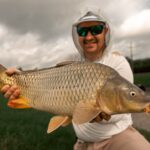
Louisiana Bull Reds Up for Harvest Again: H.B. 604 Must Not Pass
Photo Credit: Carter Abramson | Trevor Johnson Every now and then, we encounter something so
To the uninitiated, stepping into the fisheries policy space can feel daunting. Many “first timers” can relate. They’re drawn to this world through their passion for fishing and the experiences they dearly cherish. The first time commenting can be nerve racking, but when you get a chance to contribute to protecting things you love, those nerves quickly subside to feelings of empowerment and fulfillment. For those who want to get more involved, here are some helpful tips for crafting an effective public comment:
“Good Afternoon Board Members,
Thank you for the opportunity to speak regarding the newly proposed regulations for this fish species. I am here to voice my support for Option B. I am a recreational angler that spends multiple weeks every fall chasing these incredible fish. My father and I have made this trip every fall for the last seven years, bringing business to local guides, tackle shops and marinas. If this fishery continues to trend downward, we will likely choose to take our annual trips elsewhere. I support Option B, a new slot limit from XX-YY inches, because I believe it will protect crucial year classes that can support the long term rebuilding of this fishery. As the science shows, the “XX” year class is our most abundant in recent years. My family loves being a part of this angling community. We hope our grandchildren get this same opportunity. For them to do so, we need to manage with the goal of long-term abundance. Please support Option B.“
Its understandable why some have reservations about jumping into the fisheries management process. These conversations can be dense with research and operate at fast pace. Even so, your participation is all the more critical to ensuring our fisheries are managed up to our standards. We are all stakeholders. Giving a public comment is a powerful way to participate and advocate for what you care about. The public comment process is an open forum. There should be no “gotcha moments” or post-comment quizzes. Stakeholders have the opportunity to express their views and step back for the next to do so. While some may have the “gift of gab”, no one is born a great public speaker. It takes a little practice. If you are willing to try, you can make a difference. Remember, effective public comments can influence policy and raise awareness about important fisheries issues, so don’t hesitate to make your voice heard. If you don’t speak up, then who will?


Photo Credit: Carter Abramson | Trevor Johnson Every now and then, we encounter something so

This past weekend, ASGA proudly sponsored the Dirty Carp Tournament in Louisiana — and no, you didn’t misread that.

After years of data pouring in from The Albie Project, advocacy, persistence, and support from

This morning, the Connecticut Environment Committee held a hearing on House Bill 6248, a bill
We rely on our members and donations to keep fighting for a sustainable tomorrow in marine conservation.
GIVE THE GIFT OF FISHERIES CONSERVATION THIS HOLIDAY SEASON. SHOP ASGA GOODS THAT FUND FISHERIES RESEARCH & ADVOCACY CAMPAIGNS
JOIN ASGA IN CALLING FOR CRITICAL MANAGEMENT ACTION AFTER YEARS OF SPAWN FAILURES & POOR MANAGEMENT.
By using this website, you agree to our use of cookies. We use cookies to provide you with a great experience and to help our website run effectively. To learn more, please review our privacy policy.
2 Responses
“Good Afternoon Board Members,
Thank you for the opportunity to speak regarding the newly proposed regulations for this fish species. I am here to voice my support for Option B. I am a recreational angler that spends multiple weeks every fall chasing these incredible fish. My father and I have made this trip every fall for the last seven years, bringing business to local guides, tackle shops and marinas. If this fishery continues to trend downward, we will likely choose to take our annual trips elsewhere. I support Option B, a new slot limit from XX-YY inches, because I believe it will protect crucial year classes that can support the long term rebuilding of this fishery. As the science shows, the “XX” year class is our most abundant in recent years. My family loves being a part of this angling community. We hope our grandchildren get this same opportunity. For them to do so, we need to manage with the goal of long-term abundance. Please support Option B.“
Thanks for posting this. Textbook 10 out of 10 comment. Nicely done